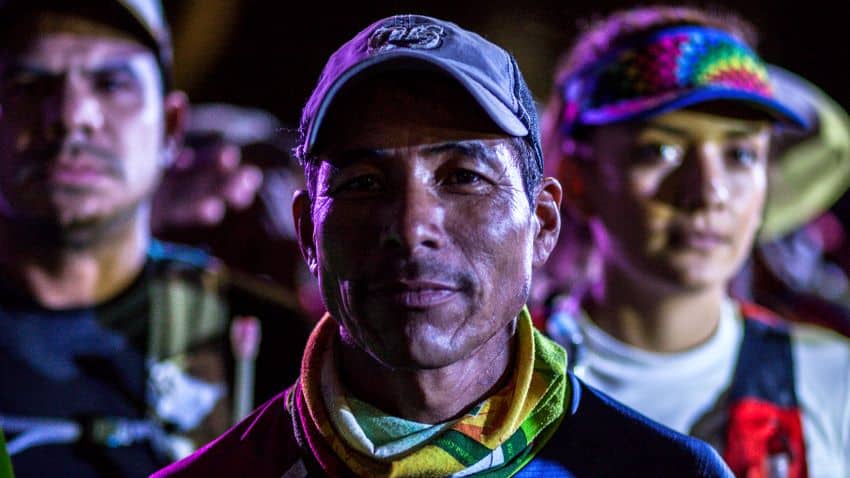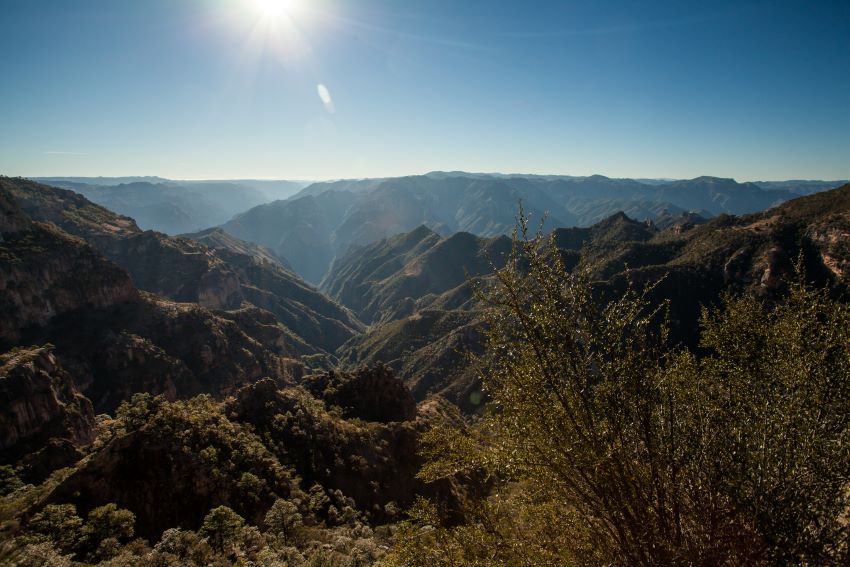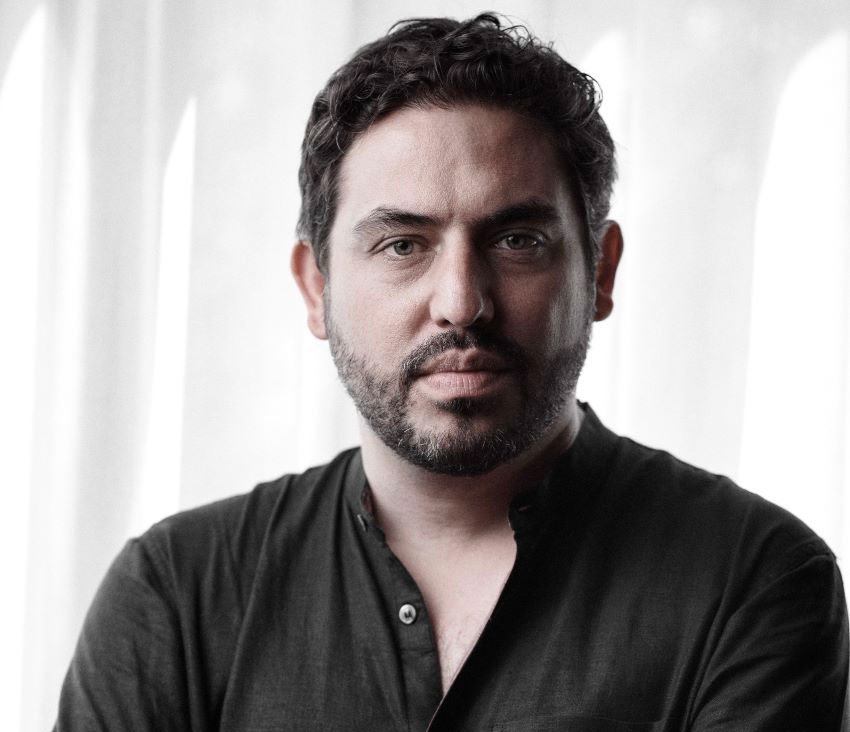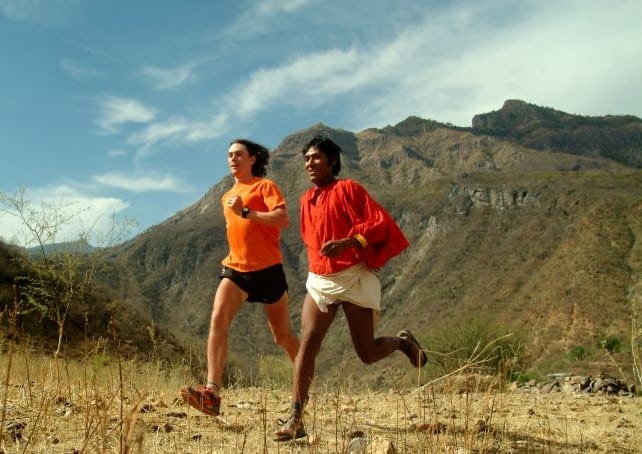In recent years, the world has grown increasingly familiar with the indigenous Mexican community of the Tarahumara, or Rarámuri. A source of that familiarity has been the Tarahumara prowess in ultrarunning, in which athletes regularly log ultramarathon-type mileage in the Copper Canyon of Chihuahua.
Yet, the attention they have received is in some ways a mixed blessing. International runners who flocked to Chihuahua for training or recreational purposes encountered some tensions while competing in ultramarathons against indigenous runners eking out a subsistence living amid conditions of organized crime and narco-violence.
In 2015, these tensions erupted prior to an ultramarathon, resulting in frustration among the Tarahumara, the visiting runners and the local government of the town of Urique. This story is part of the narrative of The Infinite Race, a new documentary by Mexican filmmaker Bernardo Ruiz, whose past works include Harvest Season, a look at Mexican migrant workers in the California wine counties of Napa and Sonoma; Kingdom of Shadows, which focuses on drug violence on the U.S.-Mexico border; and a piece on Latino baseball Hall of Famer Roberto Clemente for the PBS series American Experience.
The Infinite Race premiered on December 15 on ESPN 30 for 30 sports documentary series in the US and on the ESPN Deportes channel in Mexico.
“Feedback has been overwhelmingly positive,” said Ruiz, whose family has also welcomed a new baby during this time. “Audience response has been very, very good.”
Guanajuato-born Ruiz, a dual citizen of Mexico and the United States, traveled to the hard-to-access Copper Canyon to meet the Tarahumara. He captured the mountain scenery in gorgeous aerial shots from a Cessna aircraft while compiling multiple perspectives on the community, including through three of its members: famed ultrarunner Silvino Cubesare Quimare, activist Irma Chavez and student-athlete Catalina Rascon.

“A complex situation deserves more than one voice,” Ruiz said. “Silvino Cubesare is a veteran runner, kind of a legendary runner … Irma Chavez is an activist who is very critical of the ultramarathons Silvino has participated in. Catalina Rascón is a young up-and-comer representing a new generation, the only Tarahumara student in her high school at the time we were filming. She’s since graduated.”
Ruiz explained, “As a filmmaker, I am really drawn to stories where you don’t just hear one protagonist but voices of different perspectives.”
Yet he describes The Infinite Race as not a typical sports film but “a very different kind of film. I think it speaks to what 30 for 30 is trying to do, and is doing, in the last few years.”
Like the aerial images of the Copper Canyons, he wanted to focus a wide lens on the Tarahumara — not just on their impressive accomplishments in running, which include long-distance games with a ball, but also the increasing dangers they face from the criminal activity around them.
He learned about these dangers from “Drug Runners,” a 2017 Texas Monthly magazine article by Ryan Goldberg that looked at how organized crime groups in Chihuahua encroached on Tarahumara settlements and land.
“They’ve also been conscripting Tarahumara runners,” Ruiz explained.
According to the film, Cubesare was charged with attempting to smuggle drugs into the U.S.
Hunger and poverty are also issues for the Tarahumara, Ruiz says.
“That part of Chihuahua suffered from some very severe droughts in recent years. Illegal logging and deforestation make it harder for people just eking out a living as subsistence farmers and small agricultural producers.”

That’s why some of them run, he says.
“The race we documented [in Urique] offers an opportunity to receive vouchers for corn and other basic foodstuffs. Some runners are running for food.”
Over a decade ago, Tarahumara runners achieved fame through the bestseller Born to Run by Chris McDougall. The book also chronicled American ultrarunner Micah True, nicknamed “Caballo Blanco,” (White Horse). He was one of a few outsiders who have visited the Copper Canyon to learn how to run with the indigenous community.
A result of the book was an interest in barefoot running or minimalist footwear, which some say is a Tarahumara tradition, although this gets disputed in the film.
After getting to know the Tarahumara, True decided to create an ultramarathon that would serve several purposes, including benefiting the community.
“He had very noble intentions,” Ruiz said. “It was a kind of creation of coexistence that, in his view, would help the Tarahumara. After publication of the book in 2009, the race became a kind of bucket-list item for international runners. One American runner said the book became a kind of bible.”
True died while running in 2012, but the ultramarathon continued, named Ultra Marathon Caballo Blanco in his honor and run by professional race organizers in partnership with the local government of Urique.
Ruiz says this partnership fractured during the 2015 event because of tensions related to the race and a worsening security situation. Prior to the race, he says, there were “reports of gunfire, a kidnapping, even an execution. Race organizers were put in an impossible situation.

“What I find interesting is that for a lot of international runners, the race was a kind of paradise, utopia. [And] here you had the violence of northern Mexico, Chihuahua, kind of a rude interruption. Worlds collided. It ended up becoming a pivotal moment in the film.”
In part by using footage obtained from Canadians in town for the race, Ruiz shows the differing reactions of multiple groups to the decision to cancel the official event.
“I understand the organizers [were concerned about] liability and safety,” Ruiz said. “They did not want people to get hurt.” However, he adds, “the local government in Urique asked, ‘Who are these guys telling us to cancel? This is our town. They’re only here a few weeks, then fly out.’”
Ruiz describes the Tarahumara’s collective response as: “It’s nothing new for us. We deal with narco-violence on a regular basis. This is our chance to run and get vouchers for our families’ survival.”
“Every group in the film sees it very differently,” Ruiz reflected. “As much as possible as a filmmaker, you try — I try very hard — to not pass judgment on people but rather think about how they’re seeing the situation. I tried very hard to see everyone’s position.”
The ultramarathon continued after 2015, with some changes. Since then, the event has been “organized almost exclusively by the Urique government, the local government,” Ruiz says, with less participation from international runners, while the “previous organizers, the people who organized it from 2012 to 2015, no longer organize it as a result of the tensions that erupted in 2015.”
Ruiz could not confirm whether the ultramarathon took place this year — “I believe there was a limited race, I’m not quite [sure],” he said. “The race usually started in March, [which this year] was kind of a few weeks after the U.S. [went into] a kind of lockdown.” The next such race is scheduled for March 2021.

Asked whether he himself did any running with the Tarahumara, Ruiz replied, “I was chasing after scenes.”
He explained that he worked with a very small team, including one particular colleague who is “in better shape than I am, a better runner.”
Yet he did end 2020 with a strong finishing kick for his film on one of the world’s biggest platforms.
“It was nice to kind of close the year with a broadcast on ESPN,” Ruiz said.
Rich Tenorio is a frequent contributor to Mexico News Daily.
